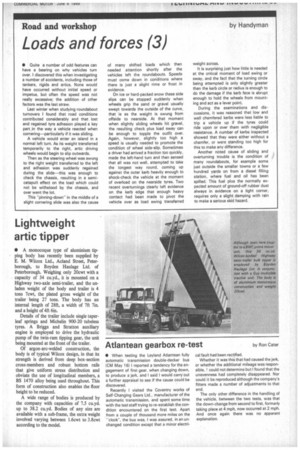Road and workshop
Page 57

If you've noticed an error in this article please click here to report it so we can fix it.
Loads and forces (3)
• Quite a number of odd features can have a bearing on why vehicles turn over. I discovered this when investigating a number of accidents, including those of tankers, rigids and artics. None would have occurred without initial speed or impetus, but often the speed was not really excessive; the addition of other factors was the last straw.
Last winter when studying roundabout turnovers I found that road conditions contributed considerably and that lost and regained tyre adhesion played a key part in the way a vehicle reacted when cornering—particularly if it was sliding.
A vehicle would enter an island in a normal left turn. As its weight transferred temporarily to the right, artic driving wheels would begin to slip outwards.
Then as the steering wheel was swung to the right weight transferred to the left and adhesion was suddenly regained during the slide—this was enough to check the chassis, resulting in a semicatapult effect on the load which could not be withstood by the chassis, and over went the lot.
This "pinning-down" in the middle of a slight cornering slide was also the cause of many shifted loads which then needed attention shortly after the vehicles left the roundabouts. Speeds must come down in conditions where there is just a slight rime or frost in evidence.
On ice or hard-packed snow these side slips can be stopped suddenly when wheels grip the sand or gravel usually swept towards the outside of the curve, that is as the weight is swung from offside to nearside. At that moment when slightly sliding wheels hit gravel, the resulting check plus load sway can be enough to topple the outfit over. Again, however, slightly too high a speed is usually needed to promote the condition of wheel side-slip. Sometimes a driver had arrived a fraction too quickly, made the left-hand turn and then sensed that all was not well, attempted to take the longest way round, coming up against the outer kerb heavily enough to shock-check the vehicle at the moment of overload on the nearside tyres. Two recent overturnings clearly left evidence on the kerb edge that enough heavy contact had been made to pivot the vehicle over as load swing transferred weight across.
It is surprising just how little is needed at the critical moment of load swing or sway, and the fact that the turning circle being attempted is only slightly greater than the kerb circle or radius is enough to do the damage if the kerb face is abrupt enough to hold the wheels from mounting and act as a lever point.
During the examinations and discussions, it was reasoned that low and well chamfered kerbs were less liable to trip a vehicle up if the tyres could ride upon or over them with negligible resistance. A number of kerbs inspected showed that they were either without a chamfer, or were standing too high for this to make any difference.
Another noted cause of sliding and overturning trouble is the condition of many roundabouts, for example some just outside the smaller towns or a few hundred yards on from a diesel filling station, where fuel and oil has been spilled. This fuel plus the normally expected amount of ground-off rubber dust always in evidence on a tight corner, requires only a slight damping with rain to make a serious skid hazard.


























































































































